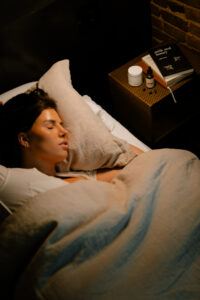Sleep is inarguably the most important habit to master for your physical, mental, and emotional health and overall vitality. Don’t believe us? In one 2013 study, healthy participants were exposed to two different conditions. For the first week of the experiment, participants experienced “insufficient sleep” and were limited to 6 hours of sleep per night. During the consecutive week, they were given a full 8-hour opportunity to experience “sufficient sleep” and catch up on their Z’s.
The researchers measured the changes in the participants’ gene activity profiles after each condition, and found two significant changes:
After one week of insufficient sleep, 711 genes displayed distorted activity. Half of these genes were over-expressed, and half were suppressed. The genes that were suppressed were those associated with a well-functioning immune system. The genes that were over-expressed were those related to the growth of tumors, heart disease, and metabolism disorders.

Now do you believe us?
So, sleep is crucial; but how do you begin to optimize your sleep hygiene and routine for the best results?
Let’s start with a brief breakdown of what happens when you’re sleeping, and then dive into how you can support each stage with simple lifestyle changes.
REM vs. Non-Rem Sleep
Sleep is separated into two broad categories: REM and non-REM. REM stands for Rapid Eye Movement, and this is the stage during which you dream. Non-REM is further divided into four distinct stages, aptly named 1, 2, 3 and 4. Stages 1 and 2 are the lighter periods of sleep, while stages 3 and 4 are the periods of deep, restorative sleep.
One sleep cycle lasts roughly 90 minutes, and this is continuous throughout the night. However, the ratio of REM to non-REM sleep during each cycle changes on an individual basis depending on a variety of factors (i.e. those affecting the circadian rhythm). Non-REM makes up about 75-80% of your total sleep, and REM constitutes the remaining 20-25%. For most healthy adults, the time spent within REM sleep increases as the night goes on. During the first half of the night, the majority of cycles consist of deep non-REM sleep; whereas during the second half of the night, you are much more likely to be in REM sleep and actively dreaming.
REM
Both categories of sleep serve specific functions, and therefore both are critical components of maintaining your health and well-being. During REM sleep, the patterns of your brain waves most closely resemble wakefulness. It’s also common to see an increase in heart rate, blood pressure, blood flow to the brain, and respiration. Despite turning “on” each of these physiological systems, there’s a complete loss of muscle tone and activity. If you have ever woken up from a dream and felt paralyzed, that’s why!
REM sleep plays an important role in the consolidation of memories, the regulation of emotions, and brain maturation.
Non-REM, Light Sleep Stages
During this Stage 1, your body is transitioning from wakefulness to sleep. The term “sleep latency” is most closely associated with Stage One; it signifies the amount of time it takes you to fall asleep. Latency for most individuals tends to vary between 10-20 minutes. However, there is a wide range of factors that can lead to a latency score outside of this average. For example, when sleep latency is less than 8 minutes, it is often a sign of sleep deprivation and overexhaustion. If you are routinely falling asleep in a matter of minutes, then your sleep debt (i.e. the cumulative amount of sleep you have missed) is certainly a contributing factor. In contrast, a prolonged latency could be associated with insomnia, nervousness, or prescription medication.
During the second stage of non-REM sleep, your body begins to prepare to drift from light to deep sleep. Physiologically, the same processes that are elevated during REM sleep, such as heart rate and respiration, begin to decrease in preparation for deep sleep. It’s common to spend more time in this transitional stage than any of the others.
Non-REM, Deep Sleep Stages
Together, Stage 3 and Stage 4 are referred to as slow-wave sleep. Brain scans taken during one of these stages show high-voltage, slow wave activity. Significantly more effort is required to wake someone from one of these stages of sleep. If it does happen, you are likely to feel tired and groggy from the interrupted slumber.
Many sleep experts believe this deep sleep is critical for brain rehabilitation and recovery, as well as memory consolidation. In fact, they often prescribe more deep sleep for individuals who are recuperating from physical, mental, and/or emotional stress. And the only way to accomplish that?! More sleep cycles, more sleep, more time in the sheets!
Circadian Rhythms: Repair Your Biological Clock
A circadian rhythm is a physical, mental, and behavioral pattern that follows a 24-hour cycle, much like the daily rotation of the Earth around the sun. These processes are unconscious; driven by the autonomic nervous system. In humans, they are controlled by the suprachiasmatic nucleus of the hypothalamus (SCN), which is responsible for regulating the timing of sleep/wake cycles, metabolism, body temperature, hormonal secretion, and emotional affect with changes in the environment’s light/dark cycle.
The SCN continuously integrates internal and external cues to recalibrate, protect, and maintain the circadian clock. When the body’s clock is disrupted, sleep patterns are disrupted, too. The long list of consequences associated with inadequate sleep already mentioned, imbalanced circadian rhythms are therefore linked to metabolic disease, neurological disease, and mood disorders.
Repair, Reset, and Find Your Momentum
Before you conquer your day, you need to learn how to conquer your sleep. It’s time to glorify your dreams; not your sleep-deprivation. In a society that applauds allocating little time to rest, be the rebel that prioritizes sufficient sleep because you know it only leads to a greater chance at success.
Resetting your sleep patterns will require you to begin incorporating a variety of non-negotiable habits into your daily routine. Some of these will be aimed specifically at repairing your circadian clock, while others will promote restfulness and relaxation. As a whole, the habits you implement for improved sleep hygiene will lay the foundation for your overall health and well-being.

Sleep Habits, Hygiene, and Health
In addition to popping your nightly MVP’s (Cured Zen and Raw CBN Night Caps), the following habits comprise the daily steps you can take to successfully support your best night of sleep.
Sleep 7-9 hours per night.
You heard it from the CDC! First and foremost, high-quality sleep depends on quantity, too! To ensure you are giving your brain and body enough time in every stage of your sleep cycle, sleep for a minimum of seven hours per night. However, where your own “optimal setting” falls in the given range is unique to you. If you notice that you tend to feel and perform at your best after 8 ½ hours, for example, then use that as your baseline for optimal well-being.
Support your wake window.
Light, specifically in the form of sun exposure, is the single most important cue affecting your circadian clock, your sleep patterns, and where they fall within each 24-hour cycle. To help restore your body’s natural clock, get at least 15-20 minutes of direct sunlight when you wake up each morning. If you think you can stand next to the window and reap the same benefits, think again! Walking outside, even beneath cloud cover, is crucial for adequate exposure.
Take this one step further by incorporating early-morning, mild to moderate-intensity exercise. Need an idea? Try going for a brisk, 30-minute walk or quick, 16-minute Tabata circuit outdoors!
Buffer your bedtime.
Chances are, you’ve heard the term “blue light” thrown around on just about every biohacking podcast episode you have listened to…ever. That’s for good reason! With light exposure being the most important contributing factor to how the SCN adjusts and regulates your circadian clock, it follows that late-night light interrupts the synchronization with natural light/dark cycles.
In fact, just one bout of blue light has the potential to delay the release of melatonin by 90 minutes! To refresh your memory, melatonin is the hormone secreted by the pineal gland that is responsible for producing a sleep-promoting effect. In healthy adults, melatonin levels are highest at night and lowest in the morning. However, exposure to artificial light before bed can negatively affect its normal secretion patterns.
Delaying melatonin increases mental alertness, prolongs sleep latency, and decreases overall sleep quality. This has cascading effects on the numerous psychological, cardiovascular, and metabolic processes that require sufficient sleep for adequate recovery and restoration. On a cellular level, late-night light even confuses the mitochondria! If you had the tendency to nap during your high-school biology class, mitochondria are the body’s energy makers. Impair them, and you impair just about every single physiological system.
Now, if you’re prone to thinking, “I’ll sleep when I’m dead,” and burning the midnight oil to put a few more hours of work into your passion project, let us set something straight. The longer you have been awake, the more sensitive you are to light. When the clock chimes 11pm, you aren’t accomplishing anything worthy of applause.
Artificial light that arrives to the eyes between 11 PM and 4 AM suppresses the release of dopamine, which can inhibit learning, impair attention, block creativity and create additional detrimental effects. If your long-term vision requires playing the long game at peak performance, you’re much better off prioritizing sleep instead of hunching over the computer screen.
To adequately buffer your bedtime and support the highest quality of sleep, aim to shut down your electronic devices at least 90 minutes before you hit the sack. Rather than sitting through a few episodes of the latest Netflix hit, try meditating and journaling to help your mind and body wind down.
Need a journal prompt?! Try this one: How am I feeling; mentally, emotionally, and physically? How would I like to feel tomorrow? What is one thing I can think, feel, and/or do to create a greater sense of presence?
Maintain a routine sleep cycle.
Start paying attention to when you think, feel, and perform at your best. Although the standard sleep cycle is from 10:00pm to 6:00am, specific bedtimes and wake times vary from person to person. Regardless of the time you choose, maintaining a regular routine supports your SCN in balancing your circadian clock.
Think about it: when you stay up and wake up two hours later on the weekends, how do you feel when Monday rolls around? Groggy, right? That’s because your body has to recalibrate your rhythms all over again! Not only will you feel more energized and focused, but a set sleep schedule will also help you fall asleep, stay asleep, and wake up with ease.
Use blackout curtains.
Did you know that being exposed to light during your sleep is linked to higher rates of mental illness, increased weight gain, and a greater probability of developing a chronic illness. It’s worth repeating: your bedroom should be a technology-free zone. Consider it a non-negotiable piece of your sleep hygiene routine.
However, light emanating from outside your windows needs to be considered, too. Whether you live in the city or out in the country, blackout curtains will keep your bedroom in the perfect condition for the deepest, most restorative sleep. If your room begins to resemble a cave, then you’re on the right track!
Set the temperature of your home to 66-70 degrees Fahrenheit.
Sleep researchers have found an ambient temperature of 66-70 degrees Fahrenheit to be the most optimal setting for sleep. Although the specific temperature may vary from person to person, this range has been associated with the best overall sleep quality.
Similarly to light, the SCN uses environmental and body temperatures to help regulate your circadian clock. Despite how cozy a warm bedroom may feel, it can actually inhibit your body’s natural sleep cycles and restorative processes (like, the glymphatic system). In fact, higher temperatures reduce sleep efficiency, increase fatigue, decrease crucial slow-wave sleep, and interrupt your REM cycles.
After you adjust your thermostat, you can help your body prepare for sleep by taking a warm bath two hours before bedtime or taking a cold shower immediately before sliding beneath the covers. Both options will encourage your body temperature to drop, signaling the release of melatonin, the onset of sleepiness, and the beginning of an efficient slumber.
There you have it; our top tips for sleep hygiene in granular detail. It’s time you (finally) get the deep, restorative sleep you’ve been aching for. Don’t you agree?










